Open System Perspective, Learning Perspective and High-Performance Work Practices in Human Resource Management
VerifiedAdded on 2023/05/30
|8
|2053
|459
AI Summary
This article discusses the Open System Perspective, Learning Perspective and High-Performance Work Practices in Human Resource Management. It explains how these practices can improve organizational efficiency and employee performance. The article also provides examples from Canadian Apartment Property Real Estate Investment Trust.
Contribute Materials
Your contribution can guide someone’s learning journey. Share your
documents today.
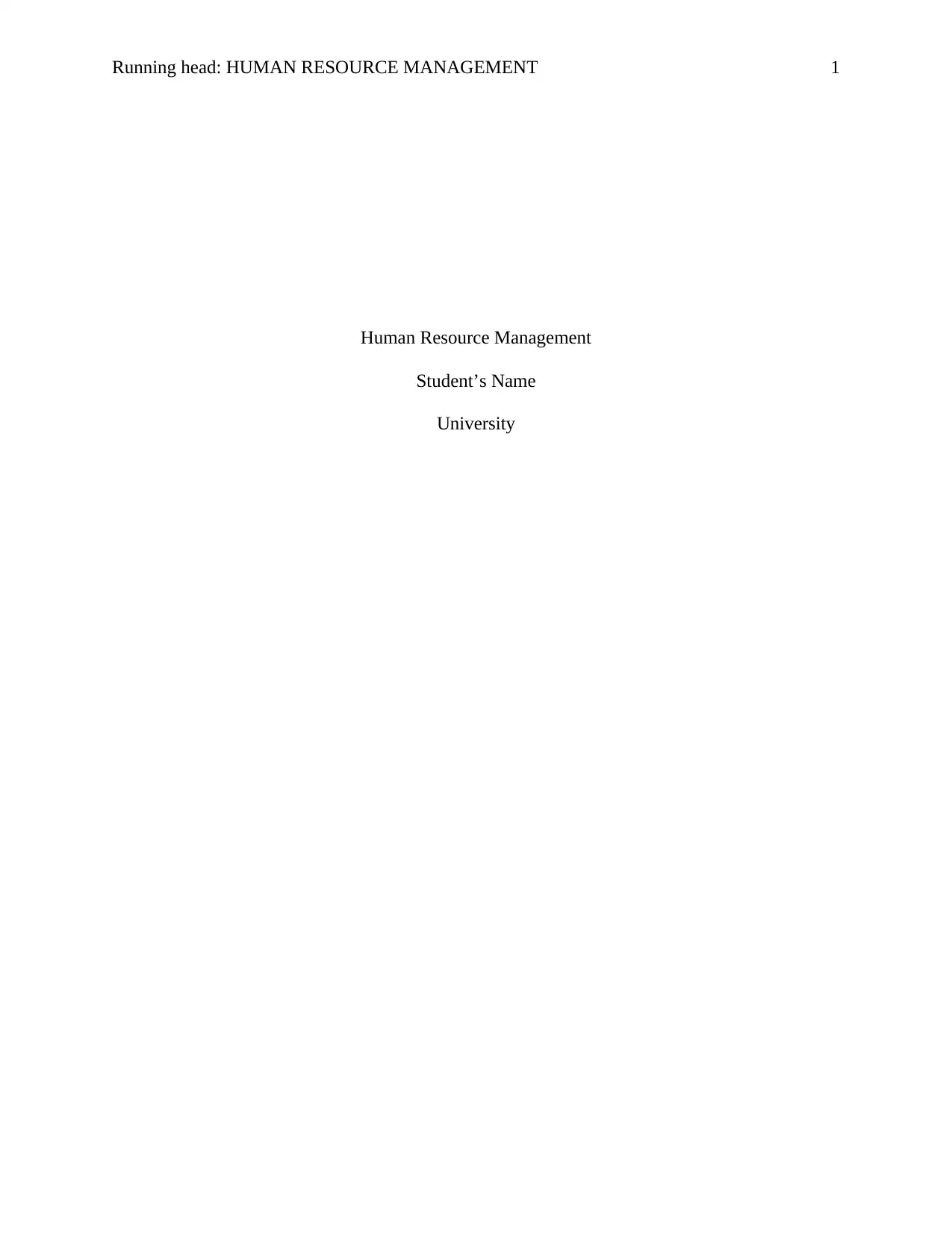
Running head: HUMAN RESOURCE MANAGEMENT 1
Human Resource Management
Student’s Name
University
Human Resource Management
Student’s Name
University
Secure Best Marks with AI Grader
Need help grading? Try our AI Grader for instant feedback on your assignments.
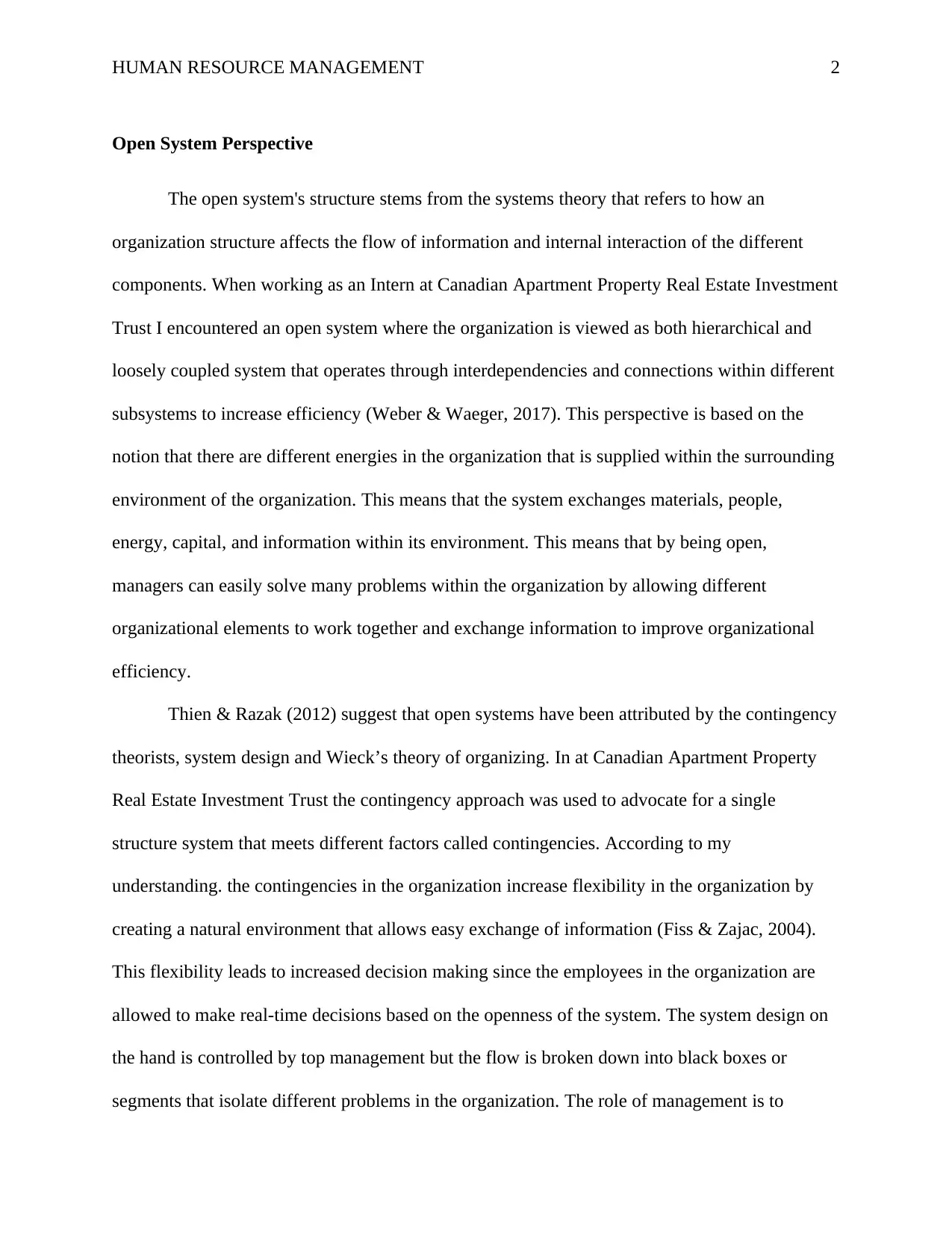
HUMAN RESOURCE MANAGEMENT 2
Open System Perspective
The open system's structure stems from the systems theory that refers to how an
organization structure affects the flow of information and internal interaction of the different
components. When working as an Intern at Canadian Apartment Property Real Estate Investment
Trust I encountered an open system where the organization is viewed as both hierarchical and
loosely coupled system that operates through interdependencies and connections within different
subsystems to increase efficiency (Weber & Waeger, 2017). This perspective is based on the
notion that there are different energies in the organization that is supplied within the surrounding
environment of the organization. This means that the system exchanges materials, people,
energy, capital, and information within its environment. This means that by being open,
managers can easily solve many problems within the organization by allowing different
organizational elements to work together and exchange information to improve organizational
efficiency.
Thien & Razak (2012) suggest that open systems have been attributed by the contingency
theorists, system design and Wieck’s theory of organizing. In at Canadian Apartment Property
Real Estate Investment Trust the contingency approach was used to advocate for a single
structure system that meets different factors called contingencies. According to my
understanding. the contingencies in the organization increase flexibility in the organization by
creating a natural environment that allows easy exchange of information (Fiss & Zajac, 2004).
This flexibility leads to increased decision making since the employees in the organization are
allowed to make real-time decisions based on the openness of the system. The system design on
the hand is controlled by top management but the flow is broken down into black boxes or
segments that isolate different problems in the organization. The role of management is to
Open System Perspective
The open system's structure stems from the systems theory that refers to how an
organization structure affects the flow of information and internal interaction of the different
components. When working as an Intern at Canadian Apartment Property Real Estate Investment
Trust I encountered an open system where the organization is viewed as both hierarchical and
loosely coupled system that operates through interdependencies and connections within different
subsystems to increase efficiency (Weber & Waeger, 2017). This perspective is based on the
notion that there are different energies in the organization that is supplied within the surrounding
environment of the organization. This means that the system exchanges materials, people,
energy, capital, and information within its environment. This means that by being open,
managers can easily solve many problems within the organization by allowing different
organizational elements to work together and exchange information to improve organizational
efficiency.
Thien & Razak (2012) suggest that open systems have been attributed by the contingency
theorists, system design and Wieck’s theory of organizing. In at Canadian Apartment Property
Real Estate Investment Trust the contingency approach was used to advocate for a single
structure system that meets different factors called contingencies. According to my
understanding. the contingencies in the organization increase flexibility in the organization by
creating a natural environment that allows easy exchange of information (Fiss & Zajac, 2004).
This flexibility leads to increased decision making since the employees in the organization are
allowed to make real-time decisions based on the openness of the system. The system design on
the hand is controlled by top management but the flow is broken down into black boxes or
segments that isolate different problems in the organization. The role of management is to
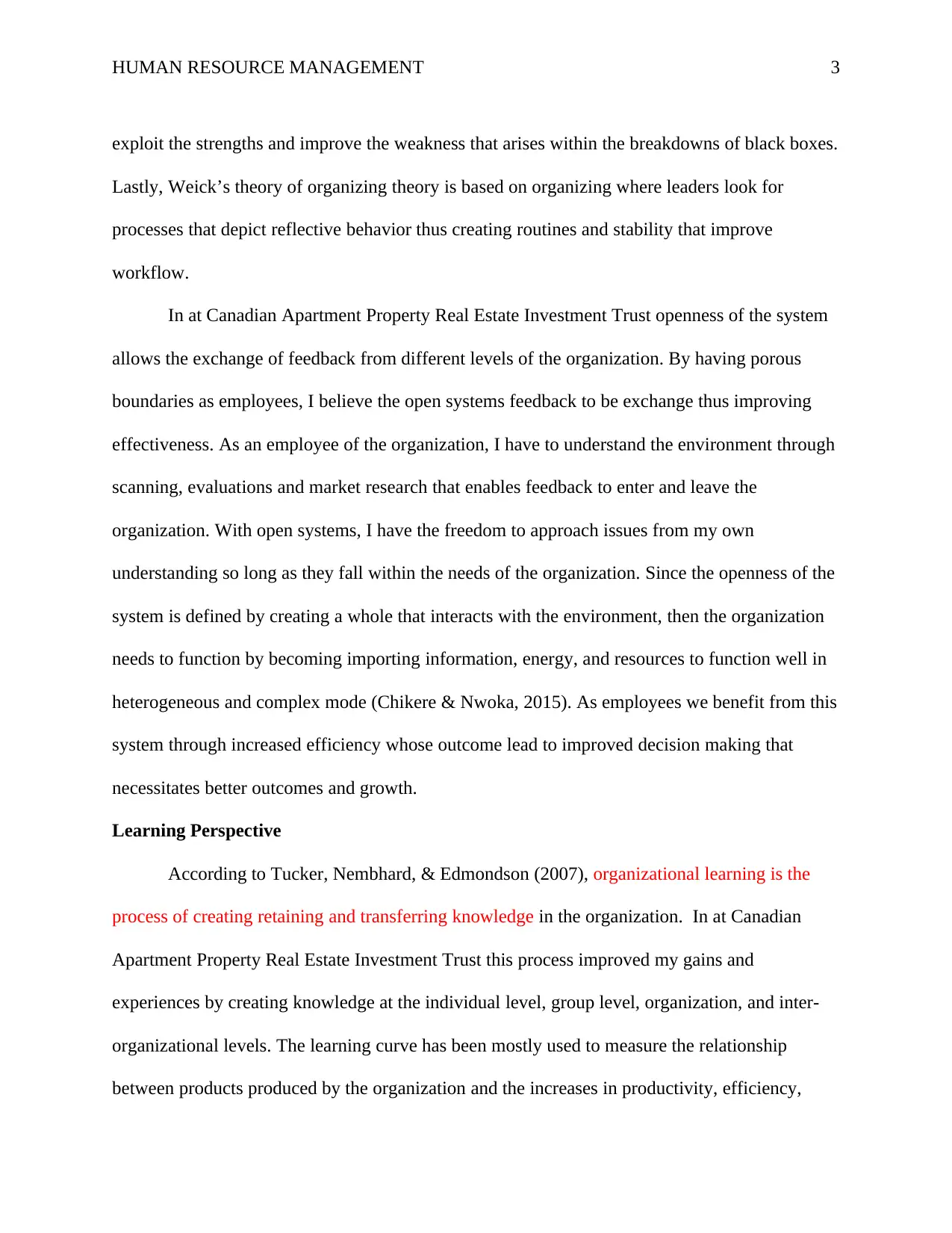
HUMAN RESOURCE MANAGEMENT 3
exploit the strengths and improve the weakness that arises within the breakdowns of black boxes.
Lastly, Weick’s theory of organizing theory is based on organizing where leaders look for
processes that depict reflective behavior thus creating routines and stability that improve
workflow.
In at Canadian Apartment Property Real Estate Investment Trust openness of the system
allows the exchange of feedback from different levels of the organization. By having porous
boundaries as employees, I believe the open systems feedback to be exchange thus improving
effectiveness. As an employee of the organization, I have to understand the environment through
scanning, evaluations and market research that enables feedback to enter and leave the
organization. With open systems, I have the freedom to approach issues from my own
understanding so long as they fall within the needs of the organization. Since the openness of the
system is defined by creating a whole that interacts with the environment, then the organization
needs to function by becoming importing information, energy, and resources to function well in
heterogeneous and complex mode (Chikere & Nwoka, 2015). As employees we benefit from this
system through increased efficiency whose outcome lead to improved decision making that
necessitates better outcomes and growth.
Learning Perspective
According to Tucker, Nembhard, & Edmondson (2007), organizational learning is the
process of creating retaining and transferring knowledge in the organization. In at Canadian
Apartment Property Real Estate Investment Trust this process improved my gains and
experiences by creating knowledge at the individual level, group level, organization, and inter-
organizational levels. The learning curve has been mostly used to measure the relationship
between products produced by the organization and the increases in productivity, efficiency,
exploit the strengths and improve the weakness that arises within the breakdowns of black boxes.
Lastly, Weick’s theory of organizing theory is based on organizing where leaders look for
processes that depict reflective behavior thus creating routines and stability that improve
workflow.
In at Canadian Apartment Property Real Estate Investment Trust openness of the system
allows the exchange of feedback from different levels of the organization. By having porous
boundaries as employees, I believe the open systems feedback to be exchange thus improving
effectiveness. As an employee of the organization, I have to understand the environment through
scanning, evaluations and market research that enables feedback to enter and leave the
organization. With open systems, I have the freedom to approach issues from my own
understanding so long as they fall within the needs of the organization. Since the openness of the
system is defined by creating a whole that interacts with the environment, then the organization
needs to function by becoming importing information, energy, and resources to function well in
heterogeneous and complex mode (Chikere & Nwoka, 2015). As employees we benefit from this
system through increased efficiency whose outcome lead to improved decision making that
necessitates better outcomes and growth.
Learning Perspective
According to Tucker, Nembhard, & Edmondson (2007), organizational learning is the
process of creating retaining and transferring knowledge in the organization. In at Canadian
Apartment Property Real Estate Investment Trust this process improved my gains and
experiences by creating knowledge at the individual level, group level, organization, and inter-
organizational levels. The learning curve has been mostly used to measure the relationship
between products produced by the organization and the increases in productivity, efficiency,
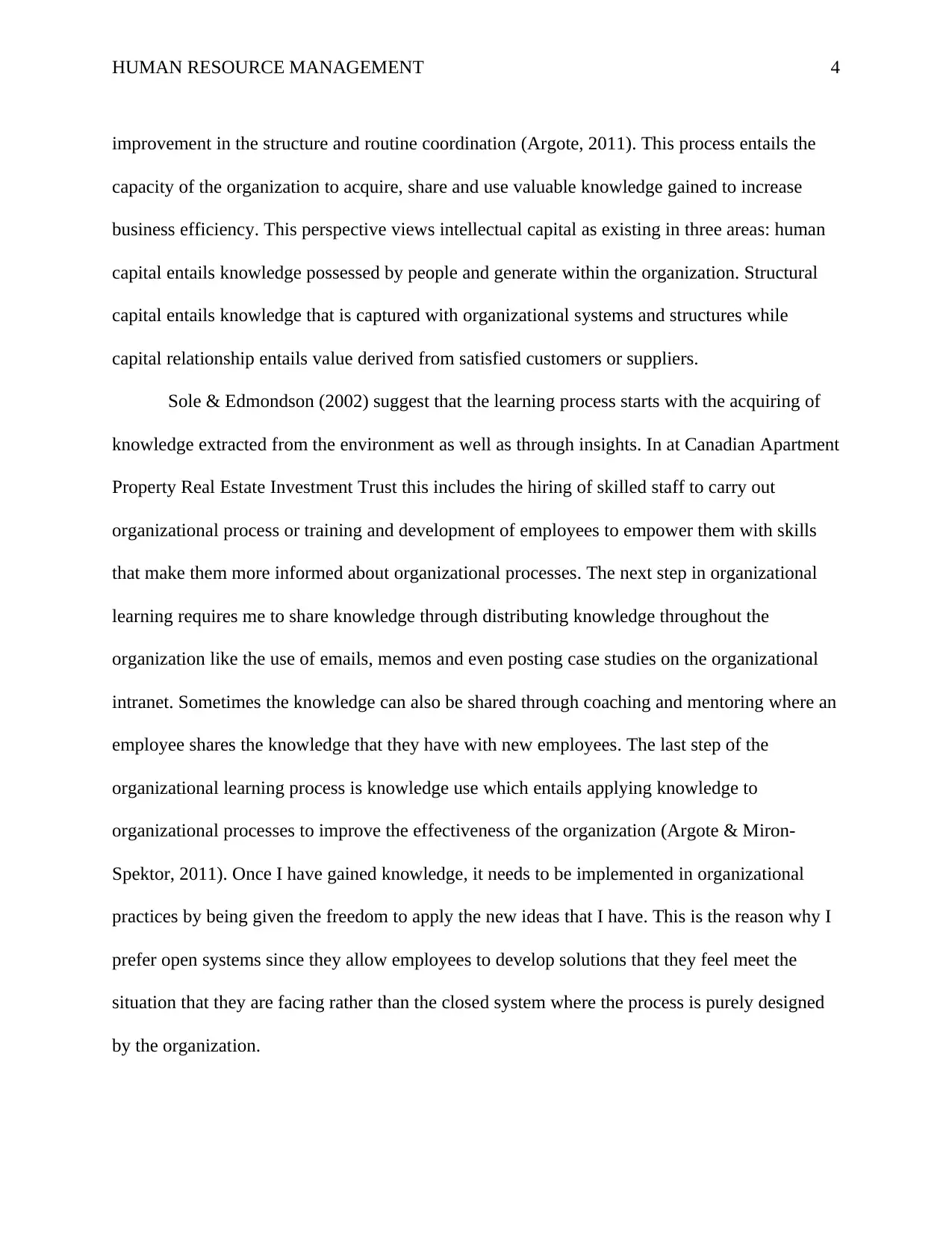
HUMAN RESOURCE MANAGEMENT 4
improvement in the structure and routine coordination (Argote, 2011). This process entails the
capacity of the organization to acquire, share and use valuable knowledge gained to increase
business efficiency. This perspective views intellectual capital as existing in three areas: human
capital entails knowledge possessed by people and generate within the organization. Structural
capital entails knowledge that is captured with organizational systems and structures while
capital relationship entails value derived from satisfied customers or suppliers.
Sole & Edmondson (2002) suggest that the learning process starts with the acquiring of
knowledge extracted from the environment as well as through insights. In at Canadian Apartment
Property Real Estate Investment Trust this includes the hiring of skilled staff to carry out
organizational process or training and development of employees to empower them with skills
that make them more informed about organizational processes. The next step in organizational
learning requires me to share knowledge through distributing knowledge throughout the
organization like the use of emails, memos and even posting case studies on the organizational
intranet. Sometimes the knowledge can also be shared through coaching and mentoring where an
employee shares the knowledge that they have with new employees. The last step of the
organizational learning process is knowledge use which entails applying knowledge to
organizational processes to improve the effectiveness of the organization (Argote & Miron-
Spektor, 2011). Once I have gained knowledge, it needs to be implemented in organizational
practices by being given the freedom to apply the new ideas that I have. This is the reason why I
prefer open systems since they allow employees to develop solutions that they feel meet the
situation that they are facing rather than the closed system where the process is purely designed
by the organization.
improvement in the structure and routine coordination (Argote, 2011). This process entails the
capacity of the organization to acquire, share and use valuable knowledge gained to increase
business efficiency. This perspective views intellectual capital as existing in three areas: human
capital entails knowledge possessed by people and generate within the organization. Structural
capital entails knowledge that is captured with organizational systems and structures while
capital relationship entails value derived from satisfied customers or suppliers.
Sole & Edmondson (2002) suggest that the learning process starts with the acquiring of
knowledge extracted from the environment as well as through insights. In at Canadian Apartment
Property Real Estate Investment Trust this includes the hiring of skilled staff to carry out
organizational process or training and development of employees to empower them with skills
that make them more informed about organizational processes. The next step in organizational
learning requires me to share knowledge through distributing knowledge throughout the
organization like the use of emails, memos and even posting case studies on the organizational
intranet. Sometimes the knowledge can also be shared through coaching and mentoring where an
employee shares the knowledge that they have with new employees. The last step of the
organizational learning process is knowledge use which entails applying knowledge to
organizational processes to improve the effectiveness of the organization (Argote & Miron-
Spektor, 2011). Once I have gained knowledge, it needs to be implemented in organizational
practices by being given the freedom to apply the new ideas that I have. This is the reason why I
prefer open systems since they allow employees to develop solutions that they feel meet the
situation that they are facing rather than the closed system where the process is purely designed
by the organization.
Secure Best Marks with AI Grader
Need help grading? Try our AI Grader for instant feedback on your assignments.
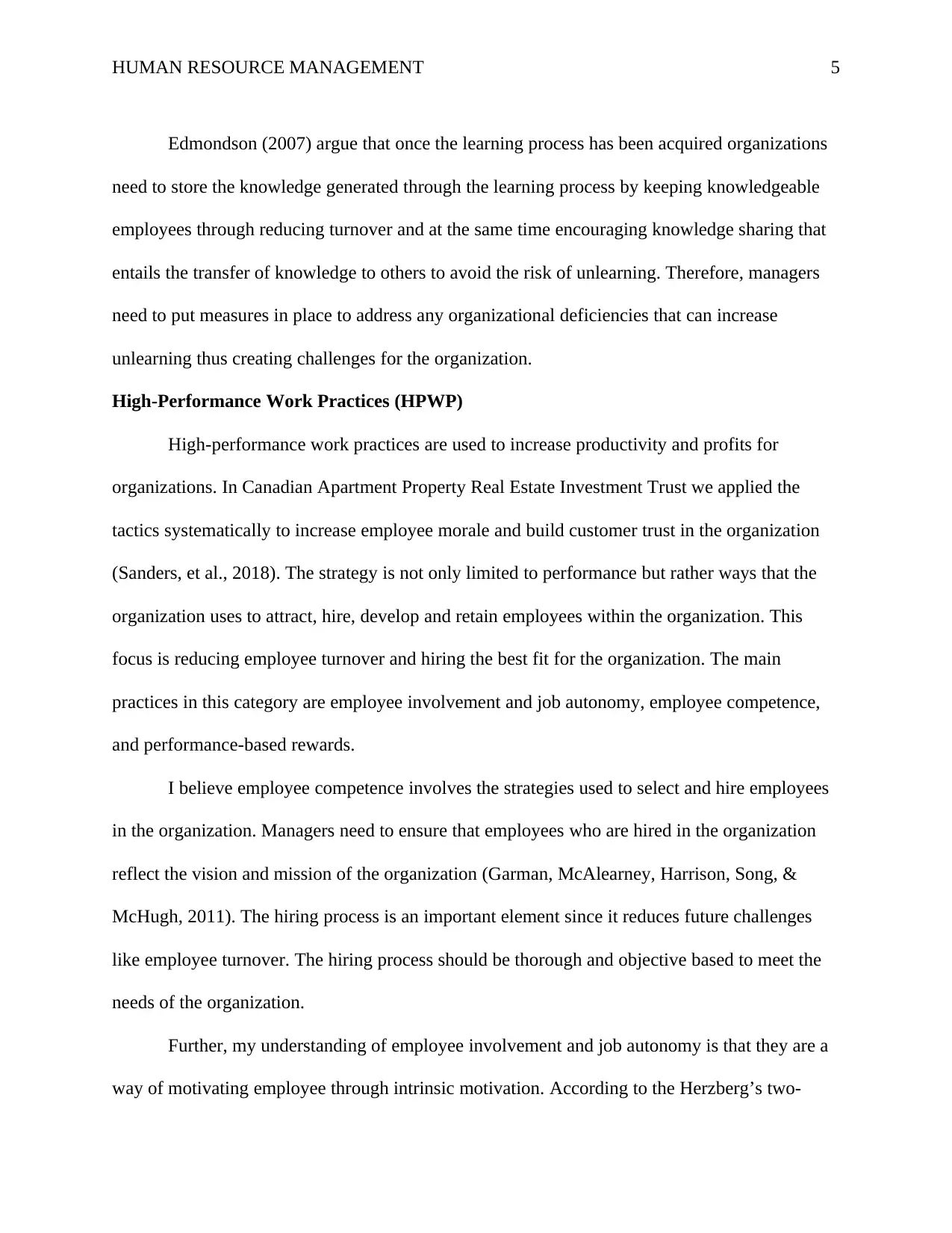
HUMAN RESOURCE MANAGEMENT 5
Edmondson (2007) argue that once the learning process has been acquired organizations
need to store the knowledge generated through the learning process by keeping knowledgeable
employees through reducing turnover and at the same time encouraging knowledge sharing that
entails the transfer of knowledge to others to avoid the risk of unlearning. Therefore, managers
need to put measures in place to address any organizational deficiencies that can increase
unlearning thus creating challenges for the organization.
High-Performance Work Practices (HPWP)
High-performance work practices are used to increase productivity and profits for
organizations. In Canadian Apartment Property Real Estate Investment Trust we applied the
tactics systematically to increase employee morale and build customer trust in the organization
(Sanders, et al., 2018). The strategy is not only limited to performance but rather ways that the
organization uses to attract, hire, develop and retain employees within the organization. This
focus is reducing employee turnover and hiring the best fit for the organization. The main
practices in this category are employee involvement and job autonomy, employee competence,
and performance-based rewards.
I believe employee competence involves the strategies used to select and hire employees
in the organization. Managers need to ensure that employees who are hired in the organization
reflect the vision and mission of the organization (Garman, McAlearney, Harrison, Song, &
McHugh, 2011). The hiring process is an important element since it reduces future challenges
like employee turnover. The hiring process should be thorough and objective based to meet the
needs of the organization.
Further, my understanding of employee involvement and job autonomy is that they are a
way of motivating employee through intrinsic motivation. According to the Herzberg’s two-
Edmondson (2007) argue that once the learning process has been acquired organizations
need to store the knowledge generated through the learning process by keeping knowledgeable
employees through reducing turnover and at the same time encouraging knowledge sharing that
entails the transfer of knowledge to others to avoid the risk of unlearning. Therefore, managers
need to put measures in place to address any organizational deficiencies that can increase
unlearning thus creating challenges for the organization.
High-Performance Work Practices (HPWP)
High-performance work practices are used to increase productivity and profits for
organizations. In Canadian Apartment Property Real Estate Investment Trust we applied the
tactics systematically to increase employee morale and build customer trust in the organization
(Sanders, et al., 2018). The strategy is not only limited to performance but rather ways that the
organization uses to attract, hire, develop and retain employees within the organization. This
focus is reducing employee turnover and hiring the best fit for the organization. The main
practices in this category are employee involvement and job autonomy, employee competence,
and performance-based rewards.
I believe employee competence involves the strategies used to select and hire employees
in the organization. Managers need to ensure that employees who are hired in the organization
reflect the vision and mission of the organization (Garman, McAlearney, Harrison, Song, &
McHugh, 2011). The hiring process is an important element since it reduces future challenges
like employee turnover. The hiring process should be thorough and objective based to meet the
needs of the organization.
Further, my understanding of employee involvement and job autonomy is that they are a
way of motivating employee through intrinsic motivation. According to the Herzberg’s two-
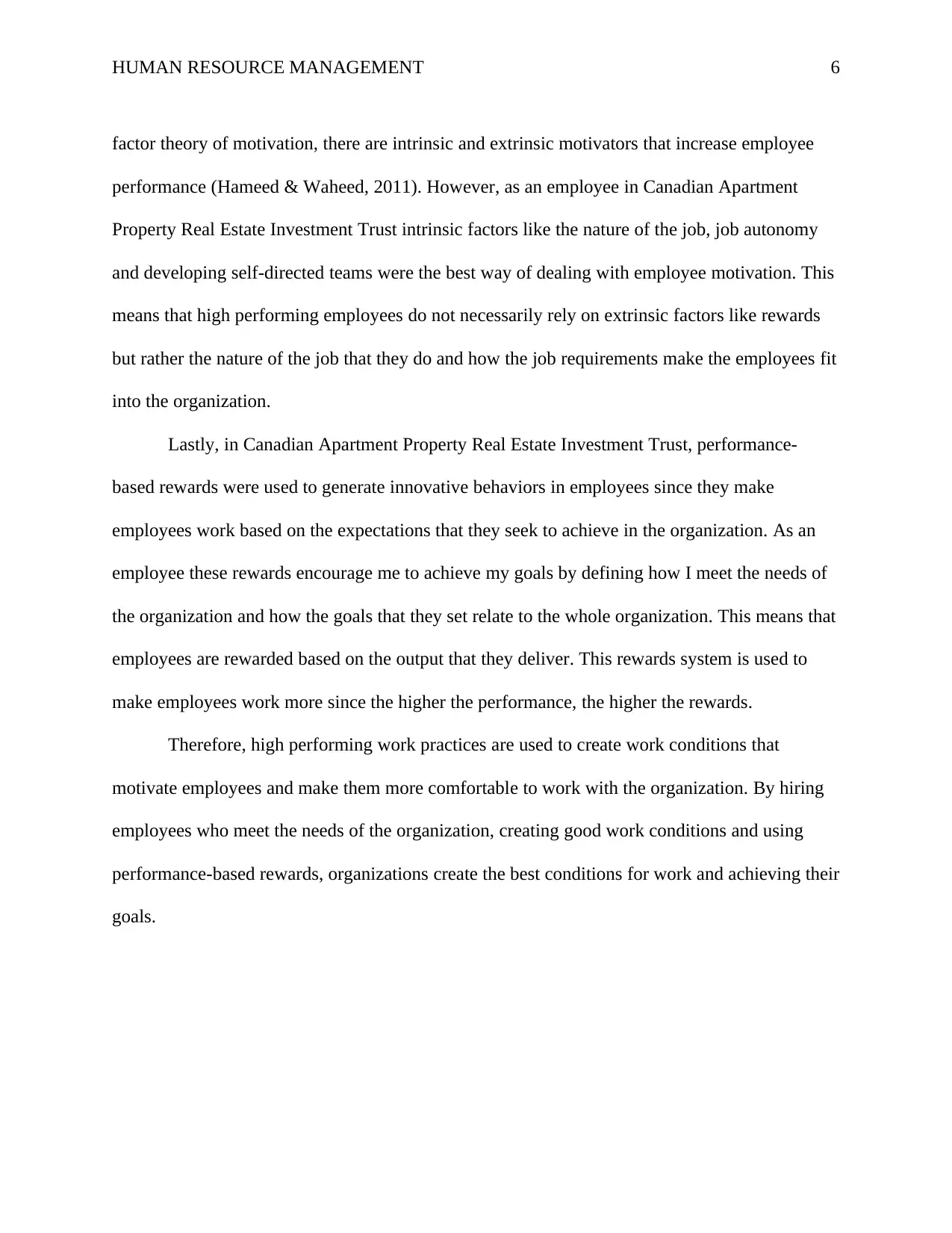
HUMAN RESOURCE MANAGEMENT 6
factor theory of motivation, there are intrinsic and extrinsic motivators that increase employee
performance (Hameed & Waheed, 2011). However, as an employee in Canadian Apartment
Property Real Estate Investment Trust intrinsic factors like the nature of the job, job autonomy
and developing self-directed teams were the best way of dealing with employee motivation. This
means that high performing employees do not necessarily rely on extrinsic factors like rewards
but rather the nature of the job that they do and how the job requirements make the employees fit
into the organization.
Lastly, in Canadian Apartment Property Real Estate Investment Trust, performance-
based rewards were used to generate innovative behaviors in employees since they make
employees work based on the expectations that they seek to achieve in the organization. As an
employee these rewards encourage me to achieve my goals by defining how I meet the needs of
the organization and how the goals that they set relate to the whole organization. This means that
employees are rewarded based on the output that they deliver. This rewards system is used to
make employees work more since the higher the performance, the higher the rewards.
Therefore, high performing work practices are used to create work conditions that
motivate employees and make them more comfortable to work with the organization. By hiring
employees who meet the needs of the organization, creating good work conditions and using
performance-based rewards, organizations create the best conditions for work and achieving their
goals.
factor theory of motivation, there are intrinsic and extrinsic motivators that increase employee
performance (Hameed & Waheed, 2011). However, as an employee in Canadian Apartment
Property Real Estate Investment Trust intrinsic factors like the nature of the job, job autonomy
and developing self-directed teams were the best way of dealing with employee motivation. This
means that high performing employees do not necessarily rely on extrinsic factors like rewards
but rather the nature of the job that they do and how the job requirements make the employees fit
into the organization.
Lastly, in Canadian Apartment Property Real Estate Investment Trust, performance-
based rewards were used to generate innovative behaviors in employees since they make
employees work based on the expectations that they seek to achieve in the organization. As an
employee these rewards encourage me to achieve my goals by defining how I meet the needs of
the organization and how the goals that they set relate to the whole organization. This means that
employees are rewarded based on the output that they deliver. This rewards system is used to
make employees work more since the higher the performance, the higher the rewards.
Therefore, high performing work practices are used to create work conditions that
motivate employees and make them more comfortable to work with the organization. By hiring
employees who meet the needs of the organization, creating good work conditions and using
performance-based rewards, organizations create the best conditions for work and achieving their
goals.
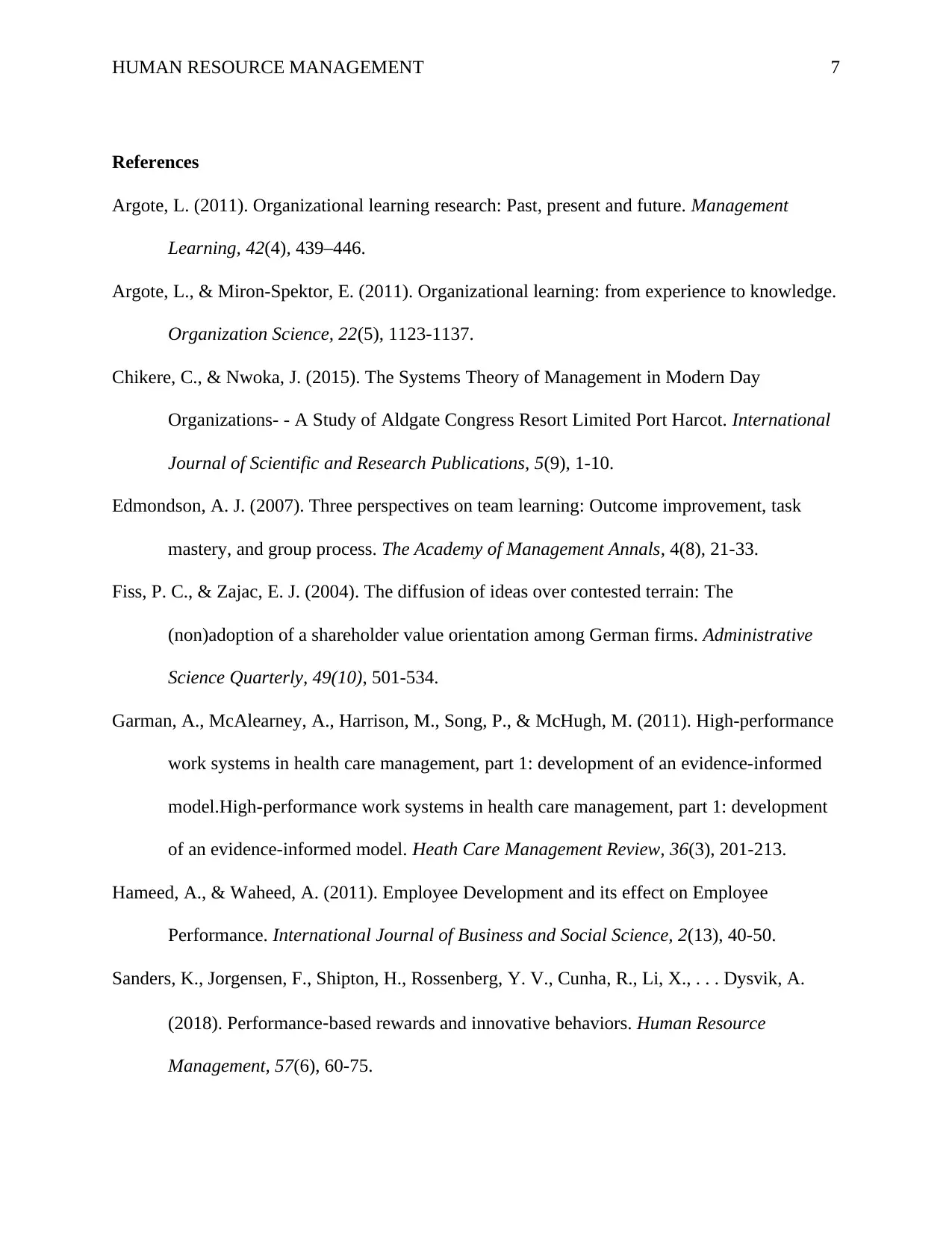
HUMAN RESOURCE MANAGEMENT 7
References
Argote, L. (2011). Organizational learning research: Past, present and future. Management
Learning, 42(4), 439–446.
Argote, L., & Miron-Spektor, E. (2011). Organizational learning: from experience to knowledge.
Organization Science, 22(5), 1123-1137.
Chikere, C., & Nwoka, J. (2015). The Systems Theory of Management in Modern Day
Organizations- - A Study of Aldgate Congress Resort Limited Port Harcot. International
Journal of Scientific and Research Publications, 5(9), 1-10.
Edmondson, A. J. (2007). Three perspectives on team learning: Outcome improvement, task
mastery, and group process. The Academy of Management Annals, 4(8), 21-33.
Fiss, P. C., & Zajac, E. J. (2004). The diffusion of ideas over contested terrain: The
(non)adoption of a shareholder value orientation among German firms. Administrative
Science Quarterly, 49(10), 501-534.
Garman, A., McAlearney, A., Harrison, M., Song, P., & McHugh, M. (2011). High-performance
work systems in health care management, part 1: development of an evidence-informed
model.High-performance work systems in health care management, part 1: development
of an evidence-informed model. Heath Care Management Review, 36(3), 201-213.
Hameed, A., & Waheed, A. (2011). Employee Development and its effect on Employee
Performance. International Journal of Business and Social Science, 2(13), 40-50.
Sanders, K., Jorgensen, F., Shipton, H., Rossenberg, Y. V., Cunha, R., Li, X., . . . Dysvik, A.
(2018). Performance‐based rewards and innovative behaviors. Human Resource
Management, 57(6), 60-75.
References
Argote, L. (2011). Organizational learning research: Past, present and future. Management
Learning, 42(4), 439–446.
Argote, L., & Miron-Spektor, E. (2011). Organizational learning: from experience to knowledge.
Organization Science, 22(5), 1123-1137.
Chikere, C., & Nwoka, J. (2015). The Systems Theory of Management in Modern Day
Organizations- - A Study of Aldgate Congress Resort Limited Port Harcot. International
Journal of Scientific and Research Publications, 5(9), 1-10.
Edmondson, A. J. (2007). Three perspectives on team learning: Outcome improvement, task
mastery, and group process. The Academy of Management Annals, 4(8), 21-33.
Fiss, P. C., & Zajac, E. J. (2004). The diffusion of ideas over contested terrain: The
(non)adoption of a shareholder value orientation among German firms. Administrative
Science Quarterly, 49(10), 501-534.
Garman, A., McAlearney, A., Harrison, M., Song, P., & McHugh, M. (2011). High-performance
work systems in health care management, part 1: development of an evidence-informed
model.High-performance work systems in health care management, part 1: development
of an evidence-informed model. Heath Care Management Review, 36(3), 201-213.
Hameed, A., & Waheed, A. (2011). Employee Development and its effect on Employee
Performance. International Journal of Business and Social Science, 2(13), 40-50.
Sanders, K., Jorgensen, F., Shipton, H., Rossenberg, Y. V., Cunha, R., Li, X., . . . Dysvik, A.
(2018). Performance‐based rewards and innovative behaviors. Human Resource
Management, 57(6), 60-75.
Paraphrase This Document
Need a fresh take? Get an instant paraphrase of this document with our AI Paraphraser
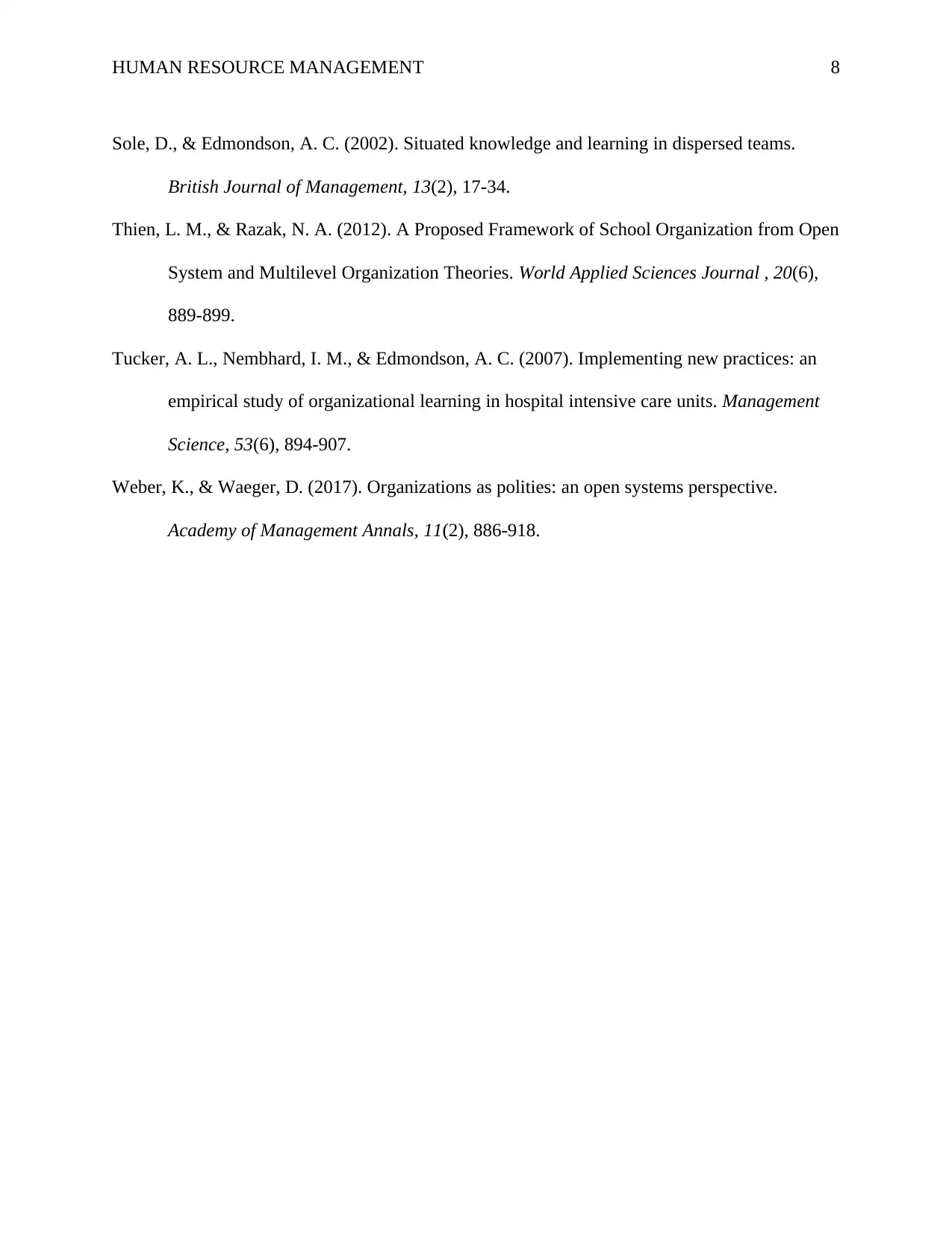
HUMAN RESOURCE MANAGEMENT 8
Sole, D., & Edmondson, A. C. (2002). Situated knowledge and learning in dispersed teams.
British Journal of Management, 13(2), 17-34.
Thien, L. M., & Razak, N. A. (2012). A Proposed Framework of School Organization from Open
System and Multilevel Organization Theories. World Applied Sciences Journal , 20(6),
889-899.
Tucker, A. L., Nembhard, I. M., & Edmondson, A. C. (2007). Implementing new practices: an
empirical study of organizational learning in hospital intensive care units. Management
Science, 53(6), 894-907.
Weber, K., & Waeger, D. (2017). Organizations as polities: an open systems perspective.
Academy of Management Annals, 11(2), 886-918.
Sole, D., & Edmondson, A. C. (2002). Situated knowledge and learning in dispersed teams.
British Journal of Management, 13(2), 17-34.
Thien, L. M., & Razak, N. A. (2012). A Proposed Framework of School Organization from Open
System and Multilevel Organization Theories. World Applied Sciences Journal , 20(6),
889-899.
Tucker, A. L., Nembhard, I. M., & Edmondson, A. C. (2007). Implementing new practices: an
empirical study of organizational learning in hospital intensive care units. Management
Science, 53(6), 894-907.
Weber, K., & Waeger, D. (2017). Organizations as polities: an open systems perspective.
Academy of Management Annals, 11(2), 886-918.
1 out of 8
Your All-in-One AI-Powered Toolkit for Academic Success.
+13062052269
info@desklib.com
Available 24*7 on WhatsApp / Email
![[object Object]](/_next/static/media/star-bottom.7253800d.svg)
Unlock your academic potential
© 2024 | Zucol Services PVT LTD | All rights reserved.

